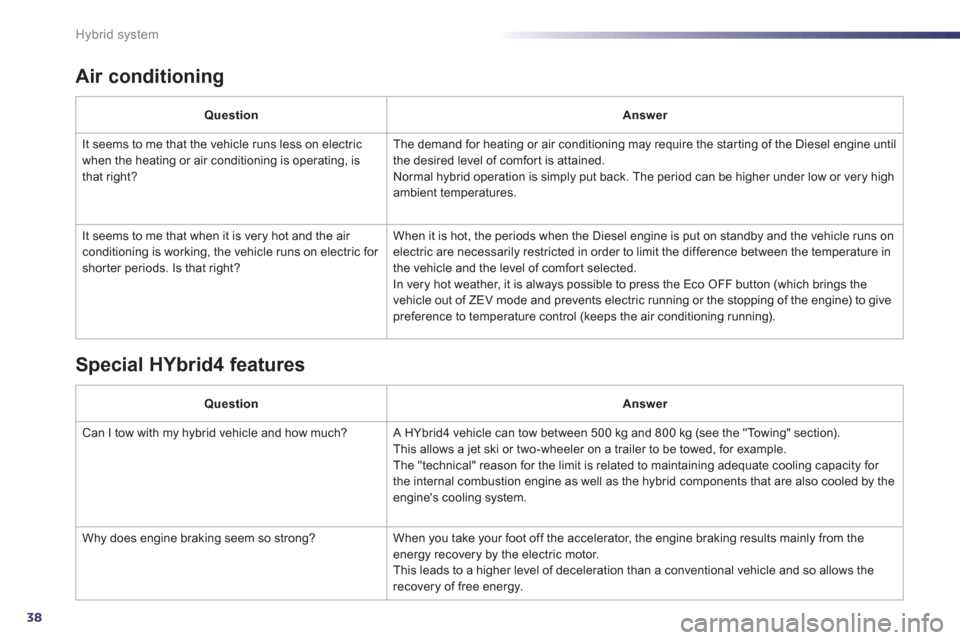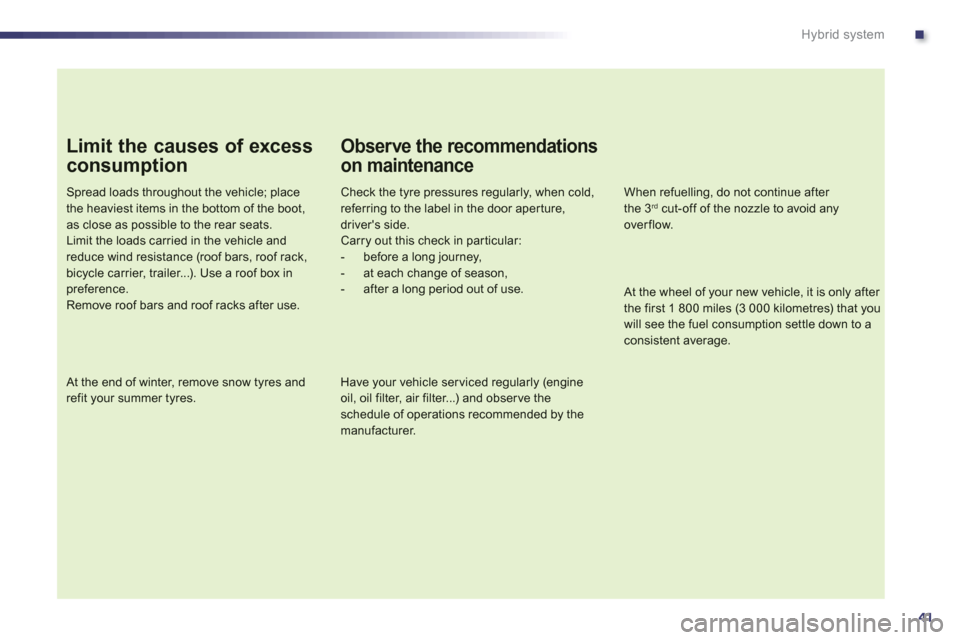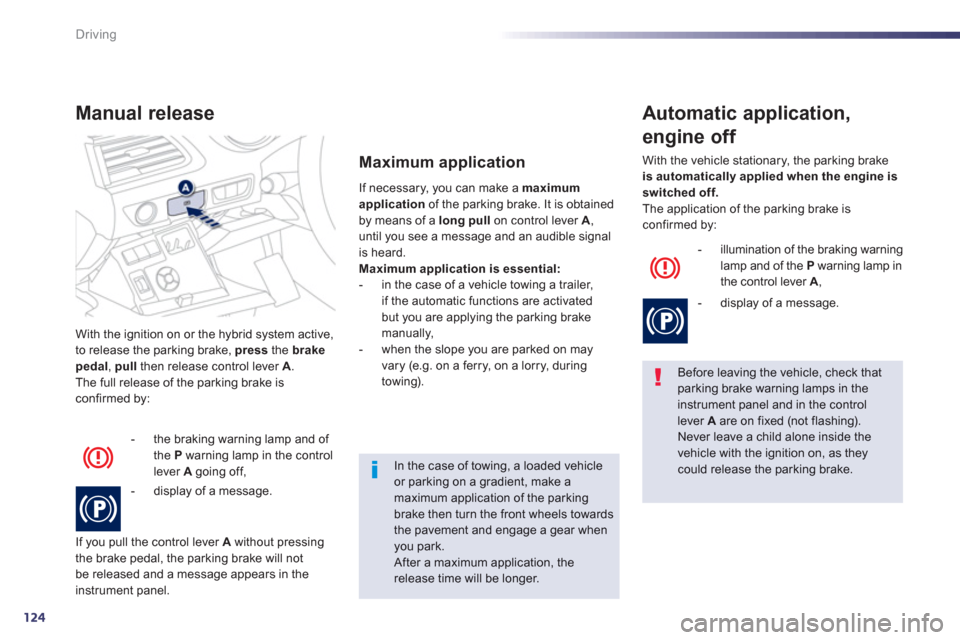Page 5 of 308
.
.
Contents
Child seats 162
ISOFIX child seats 168
Child lock 171
Child safety
Direction indicators 172
Emergency or assistance call 173
Horn 173
ESC system 174
Seat belts 177
Airbags 180
Safety
Te m p o r a ry puncture
repair kit 184
Changing a wheel 190
Snow chains 195
Changing a bulb 196
Changing a fuse 203
12 V battery 207
Energy economy mode 210
Changing a wiper blade 211
Recovering the vehicle 212
Vehicle recovery 214
Towing a trailer 215
Fitting roof bars 217
Very cold climate screen 217
Accessories 218
Practical information
Opening the bonnet 221
Running out of fuel (Diesel) 222
Diesel engine 223
Checking levels 224
Checks 227
Checks
Electric motor 230
Diesel engine 231
Diesel weights 232
Dimensions 233
Identifi cation markings 234
Technical data
Emergency or assistance 235
JBL equipment 237
Peugeot Connect Navigation (RT6) 239
Audio equipment and telematics
Alphabetical index
Visual search
Page 40 of 308

38
Hybrid system
Air conditioning
QuestionAnswer
It
seems to me that the vehicle runs less on electricwhen the heating or air conditioning is operating, is
that right? The demand for heatin
g or air conditioning may require the star ting of the Diesel engine until
the desired level of comfort is attained.
Normal hybrid operation is simply put back. The period can be higher under low or very high
ambient temperatures.
It seems to me that when it is ver
y hot and the air conditioning is working, the vehicle runs on electric for shor ter periods. Is that right? When it is hot, the periods when the Diesel en
gine is put on standby and the vehicle runs on electric are necessarily restricted in order to limit the difference between the temperature in
the vehicle and the level of comfort selected.
In very hot weather, it is always possible to press the Eco OFF button (which brings the
vehicle out of ZEV mode and prevents electric running or the stopping of the engine) to give
preference to temperature control (keeps the air conditioning running).
Special HYbrid4 features
Question Answer
Can I tow with my hybrid vehicle and how much? A HYbrid4 vehicle can tow between 500 kg and 800 kg (see the "Towing" section).
This allows a jet ski or two-wheeler on a trailer to be towed, for example.
The "technical" reason for the limit is related to maintaining adequate cooling capacity for
the internal combustion engine as well as the hybrid components that are also cooled by theengine's cooling system.
Wh
y does engine braking seem so strong? When you take your foot off the accelerator, the engine braking results mainly from the energy recovery by the electric motor.
This leads to a higher level of deceleration than a conventional vehicle and so allows the recovery of free energy.
Page 43 of 308

.
41
Hybrid system
Limit the causes of excess
consumption
Spread loads throughout the vehicle; placethe heaviest items in the bottom of the boot,
as close as possible to the rear seats.Limit the loads carried in the vehicle and reduce wind resistance (roof bars, roof rack, bicycle carrier, trailer...). Use a roof box inpreference.Remove roof bars and roof racks after use.
At the end of winter, remove snow tyres and refit your summer tyres.
Observe the recommendations
on maintenance
Check the tyre pressures regularly, when cold, referring to the label in the door aper ture, driver's side.Carry out this check in par ticular:- before a long journey,- at each change of season,- after a long period out of use.
When refuelling, do not continue after the 3rdcut-off of the nozzle to avoid any overflow.
Have your vehicle ser viced regularly (engine oil, oil filter, air filter...) and obser ve the schedule of operations recommended by the
manufacturer.
At the wheel of your new vehicle, it is only after the first 1 800 miles (3 000 kilometres) that youwill see the fuel consumption settle down to aconsistent average.
Page 50 of 308
48
Hybrid system
Vehicle recovery
position N
, then switch off the hybrid system.
If necessary because access to the vehicle is difficult, it can be moved a few dozen metres at a speed not exceeding 6 mph (10 km/h).
Th
e front or rear wheels must not be on theground, use a flat-bed lorry or trailer to recover
the vehicle.
Use the towin
g eyes only to pull a vehicle out or
to pull it onto a flat-bed.
Page 126 of 308

124
Driving
With the ignition on or the hybrid system active,
to release the parking brake, pressthe brakepedal, pull
then release control lever A.
The full release of the parking brake is confirmed by:
Manual release
- the braking warning lamp and of
the P warning lamp in the controllever A
going off,
- displa
y of a message.
I
f you pull the control lever Awithout pressing
the brake pedal, the parking brake will not
be released and a message appears in the
instrument panel. If necessar
y, you can make a maximum
applicationof the parking brake. It is obtained by means of a long pullon control lever A,
until you see a message and an audible signal is heard.Maximum application is essential:
- in the case of a vehicle towing a trailer,
if the automatic functions are activatedbut you are applying the parking brake
manually,
- when the slope you are parked on mayvary (e.g. on a ferry, on a lorry, during
towing).
Maximum application
Before leaving the vehicle, check that parking brake warning lamps in the instrument panel and in the control lever Aare on fixed (not flashing).
Never leave a child alone inside thevehicle with the ignition on, as they could release the parking brake.
Automatic application,
engine off
- illumination of the braking warning
lamp and of the Pwarning lamp in
the control lever A ,
- displa
y of a message.
With the vehicle stationary, the parking brake is automatically applied when the engine is
switched off. The application of the parking brake is confirmed by:
In the case of towing, a loaded vehicleor parking on a gradient, make amaximum application of the parkingbrake then turn the front wheels towards the pavement and engage a gear whenyou park.
After a maximum application, the release time will be longer.
Page 145 of 308

4
143
Driving
In bad weather or in winter, ensure that the sensors are not covered with mud, ice or snow. When reverse gear isengaged, an audible signal (long beep)indicates that the sensors may be dirty.
Cer tain sound sources (motorcycle, lorry, pneumatic drill, etc.) may trigger the audible signals of the parking
sensor system. In th
e event of a malfunction
of the system, when reversegear is engaged this warning
lamp is displayed in the instrument panel
and/or a message appears in the screen,
accompanied by an audible signal (short beep).
Contact a PEUGEOT dealer or a qualified
wor
kshop.
Operating fault
In addition to the rear parking sensors, the front
parking sensors are triggered when an obstacle
is detected in front and the speed of the vehicle
is still below 6 mph
(10 km/h).
The front parking sensors are interrupted if
the vehicle stops for more than three seconds
in
forward gear, if no fur ther obstacles are
detected or when the speed of the vehicle exceeds 6 mph (10 km/h).
Front par king sensors
The function will be deactivated automatically if a trailer is being towedor a bicycle carrier is fitted (vehicle fitted with a towbar or bicycle carrier recommended by PEUGEOT).
Deactivation / Activation of thefront and rear parking sensors
The function is deactivated by pressing this button.
The indicator lamp in the button comes on.
Pressin
g this button again reactivates the function.
The indicator lamp in the button goes off.
The sound emitted by the speaker (frontor rear) indicates whether the obstacle is in front or behind.
Page 207 of 308
8
205
Practical information
Fuse N°Rating (A)Functions
F3 15
Driver's electric window panel, 12 V socket for rear seats.
F
415
12 V socket in boot.
F530 One-touch rear window.
F
630 One-touch front window.
F1
120 Trailer unit.
F12 2
0 Audio amplifier.
F1
520 Panoramic sunroof blind.
F1
65 Driver's electric window switch panel.
Fuses behind the glove box
Page 214 of 308
212
Practical information
Recovering the vehicle on a fl at-bed
From the front Access to the tools
The towing eye is located behind the rear seats. �)For access to it, fold the 2/3 par t of the rear seats.
�)On the front bumper, unclip the cover bypressing at the bottom to disengage the securing lugs. �)Screw the towing eye in fully. �)Install the towing system. �)Switch on the hazard warning lamps.
Always recover the vehicle on a flatbed lorry or trailer.Never tow the vehicle with the four wheels on the ground (or the front or rear wheels only), you risk damaging the transmission. Place the gear selector in position Nand switch off the engine (Readylampoff).�)
Place the gear selector in neutral - position N
.
Failure to obser ve this special condition could result in damage to cer tain braking components and the absence of braking assistance the next time the engine is star ted. Procedure for havin
g your vehicle recovered on a flat bed lorry or trailer.